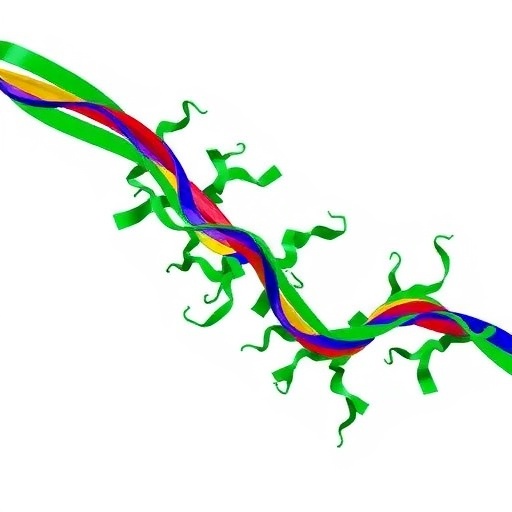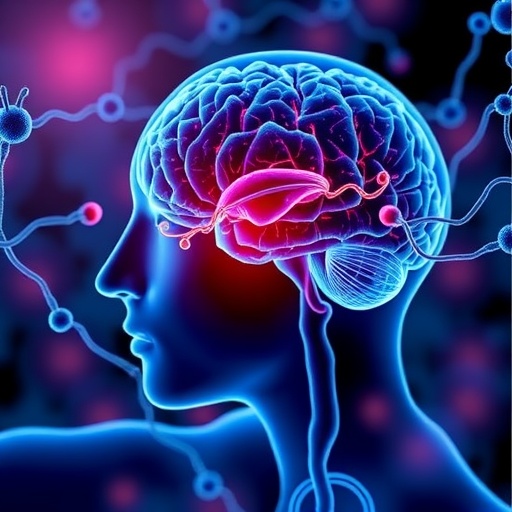In the realm of cellular biology, the architecture of chromatin within the nucleus holds pivotal significance for the regulation of gene expression, cellular identity, and overall function. A recent groundbreaking study by Li, W., Liao, Y., Liu, Z. et al., published in Nature Communications, elucidates the critical role of a specialized protein embedded in the inner nuclear membrane—LEMD3—in organizing the three-dimensional chromatin structure that sustains the identity of vascular smooth muscle cells (VSMCs). This discovery opens new avenues in understanding cellular differentiation, disease progression, and potential therapeutic intervention in vascular pathologies.
Vascular smooth muscle cells are essential components of blood vessel walls, responsible for maintaining vascular tone and integrity. Their ability to preserve identity amidst dynamic physiological stimuli is crucial for vascular health. Historically, the molecular mechanisms safeguarding VSMC identity remained elusive, with chromatin organization only partly understood. The inner nuclear membrane protein LEMD3 has now been identified as a master architect, orchestrating chromatin topology in a manner that ensures the expression of genes vital for smooth muscle functionality and phenotype fidelity.
LEMD3, or LEM domain-containing protein 3, resides on the inner membrane of the nuclear envelope, interfacing with nuclear lamina and chromatin. Prior studies linked LEMD3 mutations to developmental disorders and abnormal signaling pathways, yet its influence on chromatin architecture and cellular phenotype maintenance was not fully characterized. Li and colleagues employed cutting-edge chromatin conformation capture techniques coupled with high-resolution imaging to reveal how LEMD3 facilitates specific 3D chromatin loops and compartments tailored to maintain VSMC identity.
The investigators demonstrated that depletion of LEMD3 disrupts chromatin domains called topologically associating domains (TADs), which are essential units of genome folding that bring regulatory sequences and gene promoters into close spatial proximity. By perturbing these domains, LEMD3 loss leads to derepression of alternative lineage genes, thereby compromising the smooth muscle cell signature and predisposing cells to phenotypic switching—a hallmark of vascular disease development.
This reorganization of chromatin architecture mediated by LEMD3 has profound implications for gene regulation. The protein acts as an anchoring scaffold, binding to structural chromatin regions and organizing enhancer-promoter contacts that drive the expression of contractile and cytoskeletal components characteristic of healthy VSMCs. The research team validated these findings through transcriptomic analysis, revealing substantial downregulation of smooth muscle-specific genes upon LEMD3 knockdown, alongside ectopic activation of genes from other cell lineages such as fibroblasts and inflammatory cells.
Moreover, LEMD3’s role extends beyond passive structural support, as it interfaces with nuclear lamina proteins and mechanotransduction pathways. These interactions are critical for integrating extracellular mechanical cues into nuclear responses, thereby fine-tuning chromatin dynamics in accordance with vascular physiological demands. This mechanistic insight underscores a sophisticated regulatory circuitry wherein LEMD3 transduces mechanical stimuli into spatial genome organization and transcriptional outcomes.
From a translational perspective, these insights provide a compelling molecular explanation for vascular pathologies such as atherosclerosis and hypertension, where aberrant VSMC phenotype remodeling contributes to disease progression. Targeting the LEMD3-centric chromatin organization axis could pave the way for novel therapeutic strategies aimed at stabilizing VSMC identity, inhibiting pathological remodeling, and restoring vascular homeostasis.
The methodological sophistication of the study is notable. By integrating Hi-C chromatin conformation profiling, CUT&RUN assays for precise protein-DNA interaction mapping, and super-resolution microscopy, the research offers a multidimensional understanding of nuclear organization. Such integrative approaches set a new standard for dissecting nuclear envelope components’ roles in genome function and cellular identity regulation.
Additionally, the team explored the dynamic nature of LEMD3-mediated chromatin organization in response to biochemical and mechanical stimuli mimicking vascular stress. They observed rapid rewiring of chromatin loops and nuclear lamina contacts, highlighting the adaptable nature of nuclear architecture orchestrated by LEMD3. This adaptability is essential for VSMCs to respond to pathological insults without losing their specialized identity.
Interestingly, the work reveals LEMD3’s involvement in preventing the aberrant activation of pro-inflammatory gene programs—a feature that further consolidates its role as a guardian of vascular smooth muscle phenotype and suppressor of vascular inflammation. This dual function adds complexity to the protein’s significance and opens intriguing lines of inquiry into immunomodulation within vascular tissues.
The study also addresses the crosstalk between LEMD3 and other nuclear envelope proteins such as emerin and lamin A/C. The cooperative network among these proteins maintains nuclear integrity and establishes chromatin boundaries critical for spatial genome regulation. Disruption of this network, as evidenced by the research, leads to similar phenotypic instability, emphasizing an integrated nuclear envelope-chromatin axis.
Furthermore, Li et al. uncovered that LEMD3 engagement with post-translational modifications of histones facilitates the selective recruitment and stabilization of transcriptional repressors or activators, fine-tuning gene expression landscapes. This epigenetic dimension adds another layer of control, highlighting LEMD3 as a nexus point for chromatin remodeling and transcriptional regulation within the nuclear periphery.
The implications of this work go beyond vascular biology. The fundamental mechanisms of nuclear envelope proteins organizing chromatin in three dimensions to regulate cell identity may hold true across diverse cell types and tissues. Such universal principles could impact the understanding of developmental biology, stem cell differentiation, and cancer biology, where chromatin reorganization is pivotal.
Future research inspired by this study might explore the potential of modulating LEMD3 function pharmacologically or genetically in models of vascular disease, assessing therapeutic efficacy in maintaining vessel integrity and preventing pathological remodeling. Moreover, delineating the interplay between LEMD3 and nuclear mechanotransduction pathways could provide novel insights into cellular adaptation in response to hemodynamic forces.
In conclusion, Li, W., Liao, Y., Liu, Z. et al. have unveiled a sophisticated mechanism by which the inner nuclear membrane protein LEMD3 governs the three-dimensional chromatin landscape to preserve vascular smooth muscle cell identity. This paradigmatic finding bridges nuclear architecture with cellular function and pathophysiology, heralding a new era in understanding how nuclear envelope components dictate cell fate and maintain tissue homeostasis. The work stands as a testament to the intricate choreography of nuclear and chromatin biology fundamental to multicellular life and vascular health.
Subject of Research:
The role of the inner nuclear membrane protein LEMD3 in organizing 3D chromatin architecture to maintain vascular smooth muscle cell identity.
Article Title:
The inner nuclear membrane protein LEMD3 organizes the 3D chromatin architecture to maintain vascular smooth muscle cell identity.
Article References:
Li, W., Liao, Y., Liu, Z. et al. The inner nuclear membrane protein LEMD3 organizes the 3D chromatin architecture to maintain vascular smooth muscle cell identity. Nat Commun 16, 8826 (2025). https://doi.org/10.1038/s41467-025-63876-3
Image Credits: AI Generated
Tags: 3D chromatin organizationcellular differentiation mechanismschromatin structure and diseasegene expression regulationinner nuclear membrane proteinsLEMD3 protein functionNature Communications study findingsnuclear architecture in cellssmooth muscle functionalityvascular health maintenancevascular pathology interventionsvascular smooth muscle cells identity





